
(A must-read article for a Sanatana Dharmi)
Aravind Subramanyam is the great grandson of Brahmashri C. V. Srinivasa Iyer (Chaami Anna). He had completed his M. B. A., Bachelor of Legislative Law, and has recently done his Master's degree in Tamil from Thanjai Tamizh Palgalaikazhagam. He is now the Managing Partner of Mind Games, Ram Nagar, Coimbatore. Apart from all these, Aravind Subramanyam is a Spiritual Writer and a Speaker. He is an Atheetha Ayyappa bhaktha (Ardent Ayyappa devotee) and has been doing a lot of research on Lord Ayyappa over 25 years.
“The Punya yaatra (Pilgrimage) to Sabarimala is being undertaken by the members of our family since generations. We were able to trace back only up to 1920s, when my great grandfather used to go to Sabarimala by complying all vrata-s. Definitely, it would have started from the period even before that. I’m the fourth-generation representative undertaking this sacred yaatra as far as we are aware. I remember my father to have taken me to Sabarimala at the age of four which was my first time to the holy spot,” stated the pious Aravind Subramanyam.
He continued, “I like to read books from a young age. This habit had increased my interest to know more about Sabarimala which in turn gave rise to many queries. My first question was how did Lord Ayyappa and Vavar became friends when the Islamic invasions happened during a different time scale from that of the lord who had settled at Sabarimala,” seems logical isn’t it? “I had this doubt when I was 9. I tried to ask many elders who just shut my mouth by saying that I must not ask such a question. I had various other doubts as well.”
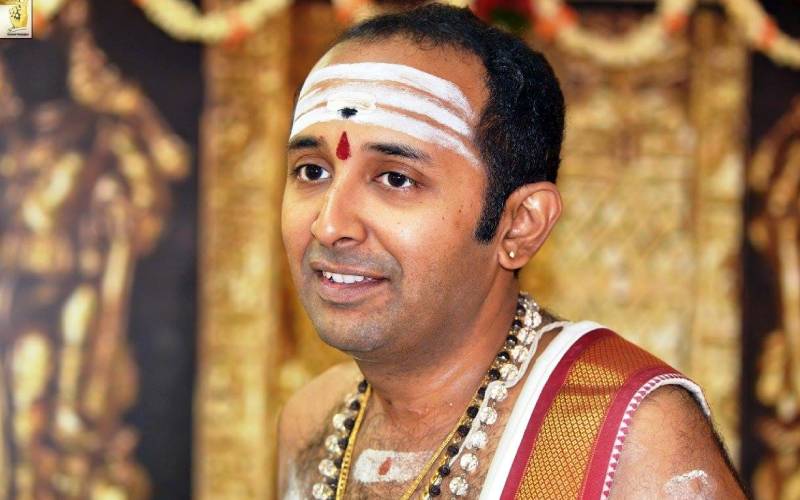
The Ayyappa bhaktha made the interview more interesting by narrating instances when he had raised many questions that even many of us would have asked. Those questions would have probably remained unanswered and in the course washed away from our minds. Now that, we dismiss all such questions as superstitions, because we did not get them answered. The real reason is that we did not search for the answers which Aravind did. Let’s check what more questions Aravind had raised and the riveting answers that he arrived at.
“If Poorna and Pushkala are the wives of Lord Ayyappa at Achhankovil, then how can the lord be a Brahmachari (Celibate) at Sabarimala? That was my next question. I soon began my quest by seeking answers, for which not many had even one. I came across many cross-references mentioned in various Purana-s (Stories which cannot be just dismissed as myths) regarding which I even had written letters to many scholars, Melshanthi-s (High-order Priests), Kottaram (Referring to the Palace of Pandalam), although I did not receive any write-backs.”
Aravind did not get fed up and stop his search. Instead, his curiosity to know more about the Supreme had given him the strength to gather information relating to his search. He began to see bits and pieces of information scattered all around, even in the rituals prescribed for the lord. He soon started visiting places to gather details about the same. His experiences and research grew along with his age.
“I wanted to write a book with all the information that I had gathered. No sooner, several new data began to pile up my mind. I came to know that Lord Manikanta at Sabarimala was only the last of the eight incarnations of Sastha and during this time the lord remained a brahmachari and remains so even today. He took the form of Lord Manikanta to destroy Mahishi (Demoness) who ruined the lives of people in earth. I also happened to read the stories of other incarnations of Dharmasastha (The one who is in-charge of Dharma).”
Isn’t he gripping?
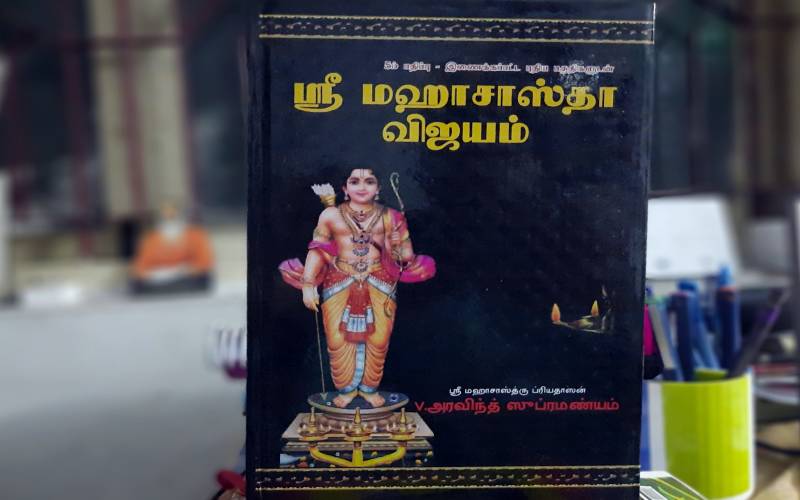
Aravind Subramanyam had written an 800-paged book titled, ‘Maha Sastha Vijayam,’ when he was 25. This book contains answers to several questions which are still unanswered in one's mind regarding Sastha. It had even served as an authority in the most-raged Sabarimala woman entry case. Swami Dayananda Saraswati of Arsha Vidya Gurukulam had written a foreword to the book. Aravind shared a jovial instance that had happened with Swamiji (A respectful way of addressing a sannyaasi).
“I requested swamiji to write a foreword for the book by handing him a copy of the same. The first question that he posed was whether the book was written by my grandfather. I said I had written it. The funny part was that swamiji did not get convinced for a long time that I had written the book. He glanced and went through the book repeatedly. He then became extremely happy and asked me whether I wanted a foreword in standard format or wanted one after he went through the entire book. I plainly said swamiji that I wanted one after he reads throughout the book.”
“After almost 20 days, on one fine early morning I received a call from Arsha Vidya Gurukulam stating that swamiji wants to meet me at 6.30 am at Coimbatore Airport. As I went to the airport, he was waiting for me with the foreword in hand. Swamiji said that I had painstakingly written this book at a young age, so he wanted to personally congratulate me. I felt blessed to receive the guru’s grace.”
Aravind Subramanyam had thought that completing the book would be his mission, but it was not. The mission continues as the gamut of the field remains growing. Soon after publishing, he had got the opportunity to intermingle with people, families, devotees connected to Lord Ayyappa and Sabarimala, which he believes is also because of the omnipresent lord. With his so far gained knowledge, he has been identifying many Ayyappa temples which were not so popularly known.
The pooja-s that were originally happening at his house without much pomp was then apprised under the banner, Shri Maha Sasthru Seva Sangam, to the public. This seva sangam consists of many youngsters who are also atheetha Ayyappa bhaktha-s like Aravind. These pooja-s which happened in a simple way have now been brought to its grandeur and have been happening since the last 12 years. The Sasthapreethi is also being celebrated here every year in Coimbatore. The Ayyappa bhaktha mentioned that the pooja-s and special Annadhaanam (Offering food to the devotees) that were commenced by my great grandfather, Srinivasa Iyer, proceed to happen even today.
C. V. Srinivasa Iyer (Chaami Anna) was the one who started commemorating the day of Panguni Utthram at Sabarimala. The kovil had remained shut during this period without even considering the fact that it was Lord Manikanta’s Janma nakshatram (Birth-star). Srinivasa Iyer was the one who legally insisted that the temple should be kept open on this day and obtained due permission from the Travancore Devaswom Board. His team of Vaidika-s (People well-versed in reciting Vedas) performed the pooja-s there on that day until 1988, which was started in the late 1950s. Chaami Anna had predicted that he shall reach the divine abode on the Panguni Utthram of 1989 with certainty and it so happened.
“We perform various pooja-s and also have been serving annadhaanam to many Ayyappa bhaktha-s by staying near the banks of River Pampa, which can be reached on taking the long route to Sannidhaanam (Abode of Lord Manikanta), often referred as Periyaanaivattam. A shed is put up on the spot where we serve the annadhaanam, typically inside the jungle, which is historically considered to be the place where the lord is said to have manifested.”
While narrating his experiences Aravind Subramanyam cheerfully pointed out, “I had been an introvert during my growing days. But because there was a need to explain my writings, left with no other choice, I grew to become a speaker as well. Now, I have been blessed with several opportunities to travel to various places around the world to deliver Pravachanam-s (Divine lectures) on Lord Ayyappa and his glories. Similar to Bhaagavata Sapthaaham (Divine lectures happening for a week with Bhaagavatam as its subject), Hariharaputra Sapthaaham have been initiated by the bhaktha-s. With the grace of bhagavan, I have written around 25 books capturing the grace of Devi and Ayyappa.”
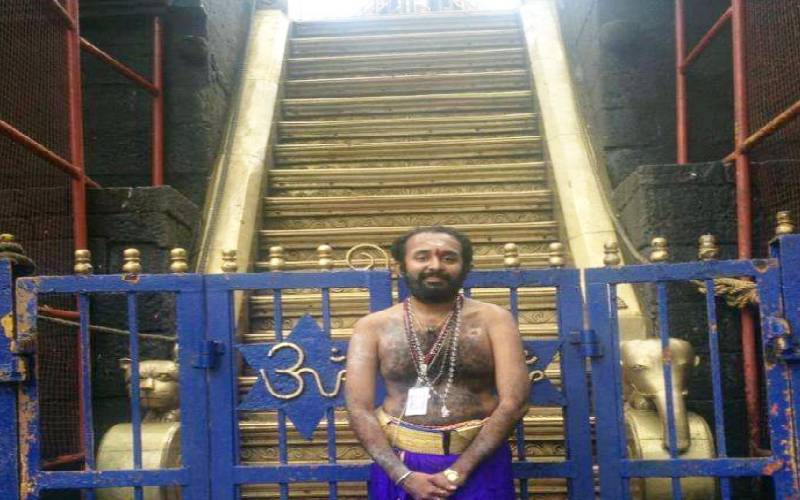
Any interview of a bhaktha can never be complete without sharing one’s divine experiences. Although, Aravind had a long list, few of his experiences which essentially capture the omnipresent divinity, in the roopa of Swami Ayyappa, has been penned in hereafter. The analysis also gives the readers the opportunity to know many unknown, compelling facts, and rebutments which were so far believed true. Let’s dive into the subject.
The Ayyappa bhaktha jumped up with enthusiasm and began, “Every year during the event of Ayyappa pooja, because of Ishvara’s grace, we have felt His divine presence. In 2012, we (His team) conducted an event called Sandharpanai, as a part of the pooja. In that section, ‘Ayyappa Ashtotharam’ (108 divine names of Lord Ayyappa) was to be chanted and pooja-s for 108 Upaasaka-s (Devotees ordained to travel to Sabarimala) had to be eventually performed.” It must be noted that this part of the pooja, Sandharpanai, is said to have happened before 500 to 600 years. The expenditure of organizing and conducting this program was completely shared by Aravind and his team.
“We needed 108 sets of pooja items which included 200 sets of poonal-s to serve the different age groups. We preferred the naturally made poonal-s which are traditionally used in the Veda Patashalaa-s. So, I had placed the order to an institute which does it and went to Muscat for delivering a pravachana. Ayyappa bhaktha-s in Muscat invited me to accompany them to Sabarimala and I did so. While I was in Sabarimala, after the darshana, I wanted to know if the poonal-s were ready for the upcoming Ayyappa Sandharpanai Pooja. I rang to the institute standing near the sannidhanam to know about the updates and I was informed that the person making poonal-s was affected by Typhoid and the work did not proceed. I turned upset.”
“I began to admonish the lord treating him as my friend. Right at that time, an anonymous person approached me and enquired if the place where he was standing was the sannidhanam. I was in a bad temper, and this added to my fury. I scowled at him saying that could not he see for himself. He calmly enquired whether I was going to perform the pooja recently. I responded him with a yes and he soon handed me a parcel and walked away. I was super-thrilled and began to uncover the parcel. You would not believe what I witnessed, there were 200 sets of traditionally made poonal-s. What would you call it? Isn’t it part of his divine play?”
Similarly, during 2013 or the following year, they had the opportunity to perform Chandi Homa at the same spot. As mentioned before, the place where they did the annadhaanam was nothing but a dense forest. Hence, for the homa they had to carry everything from pin to plane from the city and they had packed almost everything by having a checklist.
“As a part of the Chandi Homa, a Kannika Pooja had to be performed. I was aware that there were neither small girls nor ladies in our group. So, I enquired another group which had come from Madras. Fortunately, I found out that there was a 7-year-old girl in that group. I requested the child to be brought to the homa around 10 am, as the pooja was scheduled to commence early in the morning. They had also agreed to it understanding the situation,” thus the Manikanda Parichara (Follower) gripped the conversation.
“The pooja had commenced at the right time and was about to end. At the stage called Varapradhanam, the girl child came alone and stood near the homakunda. I must tell that the moment the child entered the place, we felt the place to have filled with divinity. During our previous experiences, we had not observed such a child who was filled with serenity, as most of them would be frightful. We were also excited to see the child guiding us throughout the rituals and performed all the steps with perfection.”
“After the pooja, naivedyam was given to the child which she ate gleefully. She was then proffered the clothes which was offered to Ambal during the homa. When she wore it, we felt that it was tailored only to suit the child. I would say that it was a perfect fit on her. Then, an aarati was performed and even without any instructions, she blessed everyone with the flowers offered to Goddess. All of us turned happy. On enquiring the child’s name, she responded that she was Daakshaayani. After which the child moved off from the place.”
The divine twist in the tale lies here.
“It was around 12.30 pm, when a man entered the spot with a child. He apologized us for the delay in bringing the child to the pooja. He, then, asked whether the pooja was over. We were all stunned. We did not know who that child was, which attended the pooja. Even till date, no one knows about the whereabouts of the child. Isn’t she but a manifestation of that Chandi herself? What do we call all these as? Just divine coincidences?”
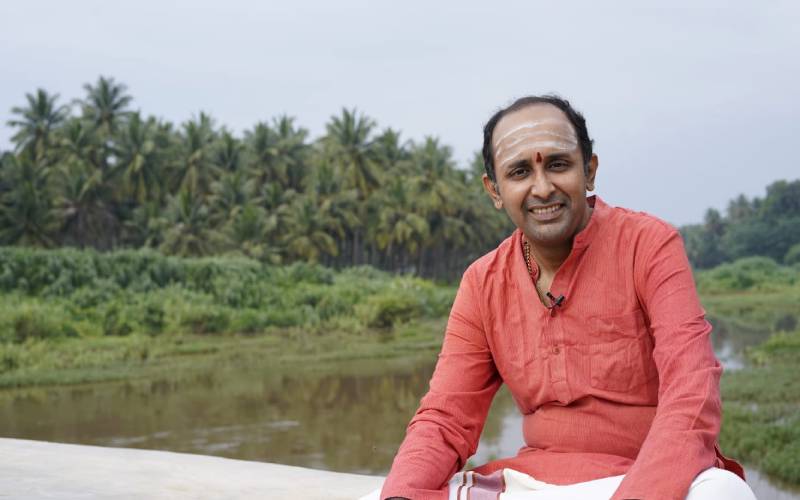
The lively conversation that Aravind had with us, took us aback. The ardent Ayyappa bhaktha agreed to the stance that it was only because of Ayyappa’s grace that he had been able to write a book. He also opined about the disbelief that he feels on re-reading the book whether, he, really wrote it. Aravind gladly offers every result that he has gained to the lord and accepts everything as Ishvaraprasada.
One of the strongest pieces of evidence found in the book named, ‘Bhoothanaatha Upaakyaanam,’ had been used, to allege against the plaintiff in the Sabarimala women entry case. The ‘Bhoothanaatha Upaakyaanam’ was said to be the part of ‘Brahmanda Purana’ and it could be claimed to be the only official document available regarding the practices followed in Sabarimala.
“The unfortunate situation was that the ‘Upaakyaanam’ was not available in print for usage. It was only available as manuscripts. In Kerala, before 120 years, someone had written a kili paatu based on this ‘Bhoothanaatha Upaakyaanam.’ This kili paatu is considered to be the literal translation of the ‘Upaakyaanam’ which consisted of around 740 verses. We did an extensive search for the original copy of the book throughout most of the oldest libraries in India. But we did not get it. All the information that I gathered was only received in fragments.”
“The notes of Baladhandayudha Swami of Kerala, Meenakshi Sundaram Iyer of Kambamkudi, C. V. Srinivasa Iyer of Palakkad (My great grandfather), Krishnan Kartha of Kallarackkal, Narayanan Pillai of Kurumulloor, and several others had shared with me the information which they had written in their books using multiple cross-references. I compiled all of them and the information found in palm-leaf manuscripts into a book during the lockdown period of 2020. For the first time, the paperback copies of ‘Bhoothanaatha Upaakyaanam,’ was made available both in Tamil and English,” smiled the deeply devout Ayyappa bhaktha.
Although the ‘Bhoothanaatha Upaakyaanam’ consisted of some 740 verses, Aravind said he was able to recover around 400 verses which consisted of the main story. Another absorbing information that Aravind shared was that there are many Gita (Holy songs) found in Sanatana dharma which includes ‘Bhagavad Gita,’ ‘Ashtaavakra Gita,’ ‘Ripu Gita,’ ‘Shiva Gita,’ etc. Similarly, there is something called ‘Bhoothanaatha Gita’ which the Lord Manikanta expounded to his stepfather, Raja of Pandalam, Rajashekara Pandiyan.
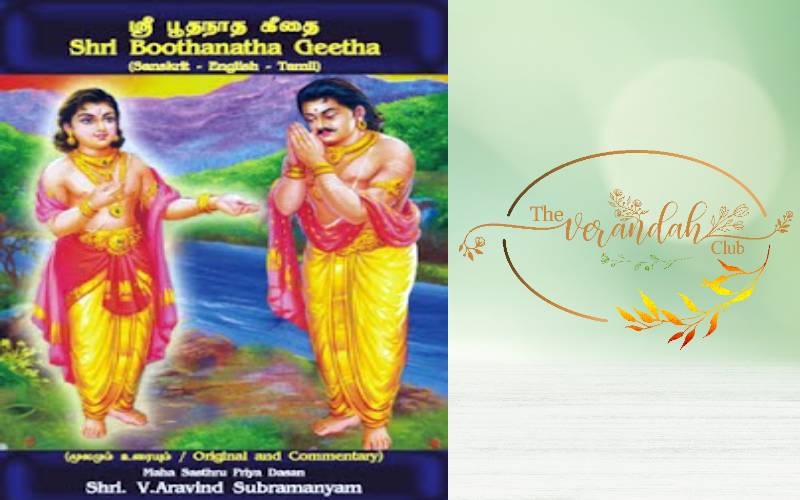
“I got hold of someone in Bombay who had the original manuscripts of ‘Bhoothanaatha Gita.’ This forms a part of the ‘Upaakyaanam’ where three out of the fifteen chapters comprises of it. It is in the question-and-answer pattern and encompasses the entire philosophy section. I was blessed to publish even that part as a book. The ‘Bhoothanaatha Upaakyaanam’ covers the commonly asked questions like why men are only allowed to take the holy yaatra, what are the vrata-s that needs to be followed to undertake this pilgrimage, etc., and the answers to them. In fact, there is a chapter in it called ‘Sabarigiri Yaatra Vidhi Nirnayam,’ which provides solution to several of our interrogations regarding Sabarimala yaatra.’”
Pandalam Royal Family, Sabarimala Tantri (A particular sect of Malayali priests who only take care of the temple and the rituals that are followed there) Mahesh Mohan, and Sasi Kumar Varma had released Aravind Subramanyam’s book. It had immediately caught the market and no sooner there was a demand for the second edition of the book, immediately after one week of its publication.
On questioning about the significant practices to be followed after being ordained to Sabarimala, Aravind eloquently answered establishing the fact, “As far as Sabarimala is concerned, keeping up every practice is important. Still, the ultimate goal of the yaatra remains realizing Tat tvam asi (Thou art that). One can find this mahavaakya engraved at the entrance of Manikanta sannidhanam. It is just to remind us that I and Ishvara are the same. This is the reason why every person who is ordained to Sabarimala is greeted as Swami. I would say, that is the crux of Sabarimala yaatra.”
“The difference between bhaktha-s of other deities and Ayyappa lies even in the way they are greeted. While other devotees are just addressed as bhaktha-s of a particular deity, devotees of Ayyappa are given the same status of the lord. We must always remind ourselves of the oneness every time we address a Ayyappa devotee as Swami. This must be kept in mind from the day people adorn themselves with a tulasi maala and get themselves ordained with the help of a Guruswami (An experienced Ayyappa bhaktha who usually had visited Sabarimala many a time).”
Every piece of information that the Ayyappa bhaktha-writer-speaker shared, indeed, would mesmerize the readers. Aravind winded his experiences by quoting more amusing details about Sabarimala.
“A lot of people still believe and write about the life of Ayyappa mentioning that the powers of Lord Shiva and Mohini combined to give birth to Lord Ayyappa, and they eventually abandoned the child at the embankments of River Pampa, which is not true. The truth is that the child born to the divine couple is Dharmasastha i.e., Hariharaputra. He had been living with Lord Shiva in Kailasa. During which He manifested himself in eight avataara-s to re-establish the dharma in earth. The last of these eight avataara-s is taken to destroy Mahishi, the demoness.”
The story goes as, “Lord Shiva, one day, called up Sastha and asked him to manifest in earth to finish the chapter of the demoness, Mahishi. Hence, the Dharmasastha was born as Lord Manikanta near the banks of Pampa. This story had been properly recorded in the ‘Bhuthanaatha Upaakyaanam.’
“I have another fascinating information which people often misinterpreted. They mistook the Sanskrit word mani for a Tamil word which means bell and had misplaced the painting of a bell on the Kanta (Throat) of the lord as his name sounded Manikanta. In Sanskrit, a gem is called as mani. When Parameshwara, Lord Shiva, asked Dharmasastha to manifest in earth, He had gifted a Navarathnamani maala (Garland of nine special gems) to Sastha. When Sastha was born in earth with the navarathnamani maala, he was addressed as Manikanta. In Manikanta Avataara, the lord remains a Brahmachari (Bachelor).”
“Other than this, in various other avataara-s, he had several consorts which includes, Poorna and Pushkala; Prabha, and a child born to them, Sathyakan; etc. In Kerala there are several temples dedicated to Prabha Sathyakan Sametha Dharmasastha. There is a place called Thrikunnapuzha near Alappey. Samraat Ashoka had entrusted a copper plate to a temple there, which has a six-foot Sastha idol along with Prabha and Sathyakan.”
The presumption is that one would have got convinced with almost all the doubts explained with reasons. Still, the possible question that would linger in one’s mind is, why is Sabarimala called so and when did Lord Ayyappa meet Sabari, the character that appears in Ramayana?
The Kula (Clan) in which one is born is important and that is why every brahmin utters abhivaadaye before prostrating elders. It can even determine a person’s name and eventually a place name. Let’s see how.
“There lived a tribal community in the hill called Sabara and a woman who belonged to that tribe was called Sabari. Despite being the fact that she was born in a tribal community, she remained a atheetha bhakthaa of Dharmasastha and attained moksha through her devotion for the lord. This is why the hill is referred to as Sabarimala which is clearly mentioned in ‘Bhuthanaatha Upaakyaanam.’”
“The text also clearly mentions that the mosque built for Vavar in Erimeli is a later addition made in the story. It could be noted that there is no particular reference to this Islamic character made in the ‘Upaakyaanam.’ Additionally, the pauranic name of current location of Erimeli was known as Mahishi Maarika Vanam. Eons ago, at the same location, resided one of the bhootha gana-s of the lord by the name Vaapuran. It was believed that the Vaapuran blessed the bhaktha-s who trailed their way to Sabarimala. No one knows whether the name Vaapuran was changed to Vavar intentionally or incidentally.”
“There is also another story relating to Vavar. He was originally a pirate. There was another Ayyappan in the Pandalam Royal Family known as Arya Kerala Varma. He is believed to have fought with Vavar and subdued him, on the request of Kaayamkulam Raja. It was also this Ayyappan who had rebuilt the Sabarimala Sastha Temple when it was damaged by many dacoits. He was believed to have been a yogi.”
Possibly, all these interventions created more confusion in the history, thereby making the people believe in pseudo-narratives.
The question raised regarding the truth behind the makara vilakku brought out the spiritual essence through the words of highly matured atheetha bhaktha, Aravind. He said, “Be it a man-made or a natural phenomenon, as a bhaktha what one must have practiced is seeing bhagavaan in everything. If one can witness Lord Manikanta in the Panchaloha vigaraha (Idol made of five precious metals) found in the sanctum sanctorum of Sabarimala, then it is for sure that the person can also see the lord in the makara jyothi.”
A thorough reading of this article changes one’s perspective about Sabarimala. This is definitely a myth-breaker which all Swamimaar (Devotees of Lord Ayyappa) must know. There are innumerable miracles that envelope Sabarimala. May Lord Ayyappa bless us to realize our real swaroopa and bestow us with His divine grace to understand the mahavaakya!
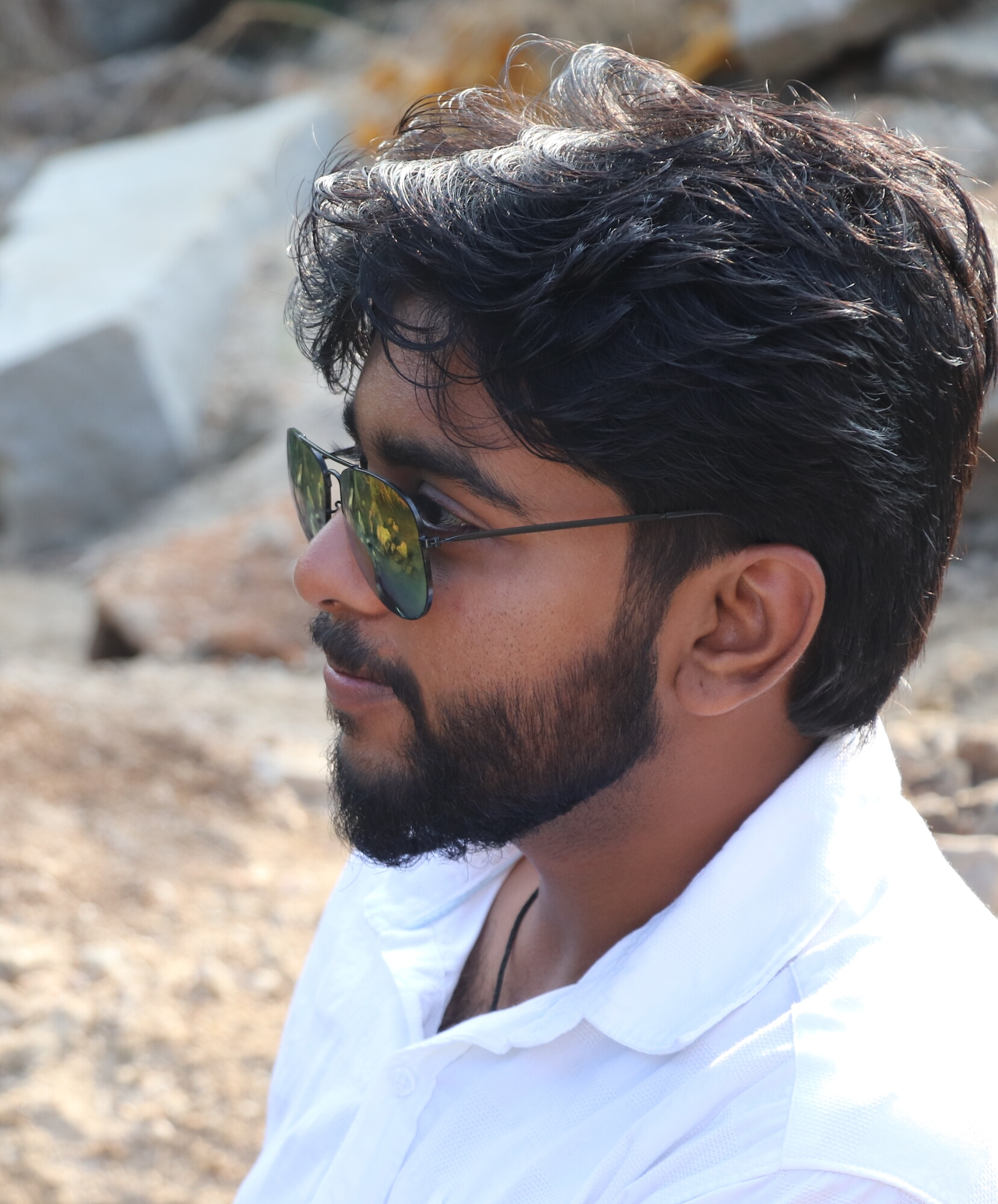
T. R. Surya is the special correspondent of the company. He is an eloquent speaker and compendious writer of English. An avid learner of Sanskrit and Indian scriptures under the guidance of Swami Ganeshaswarupananda and Gita Chaitanya of Arshavidyalaya. His inclination and interests are towards studying Metaphysics and philosophies.
NEXT ARTICLE
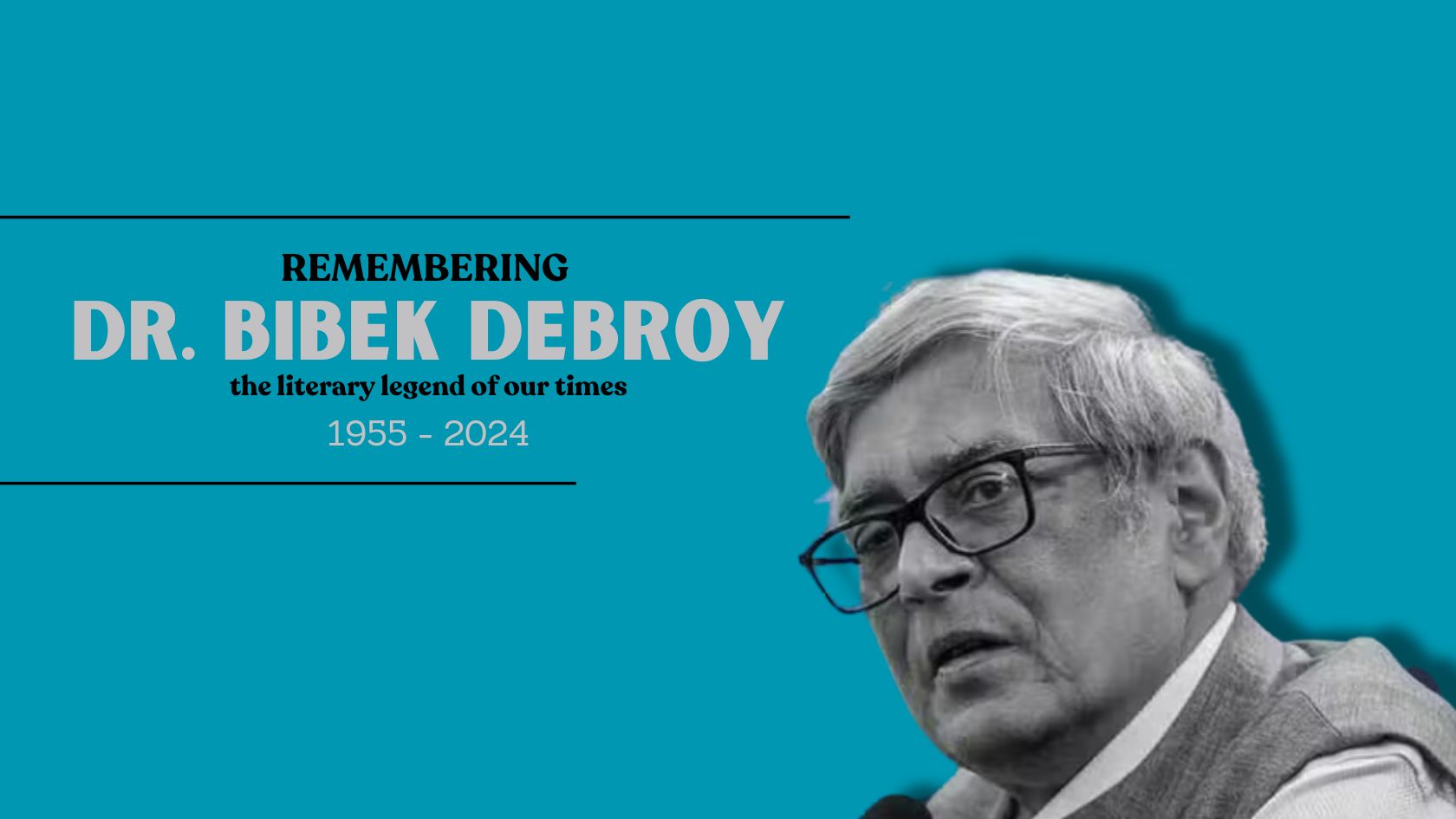
All authors who write about the Mahabharata have to read its unabridged version. The most popular unabridged translation used to be the one by Kisari...
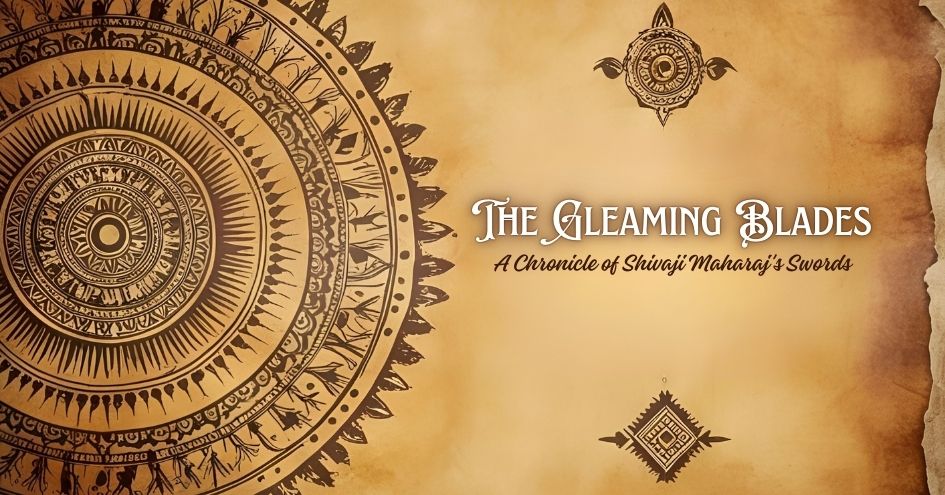
In the annals of Bharat Varsh, amidst the swirling mists of time and legacy, emerges the figure of Chhatrapati Shivaji Maharaj, a warrior whose name e...